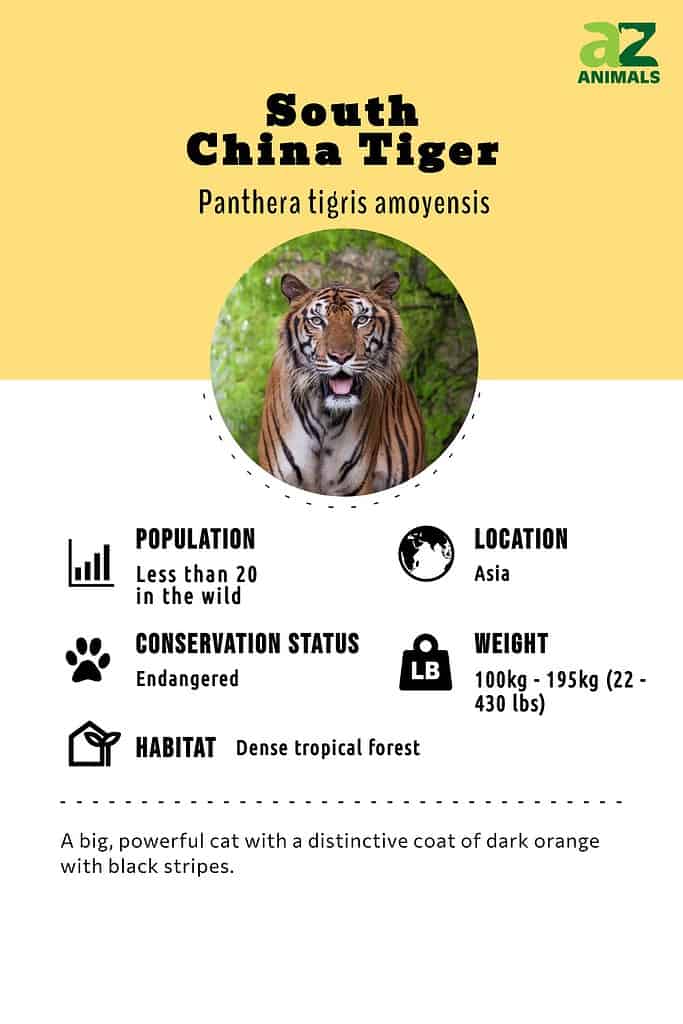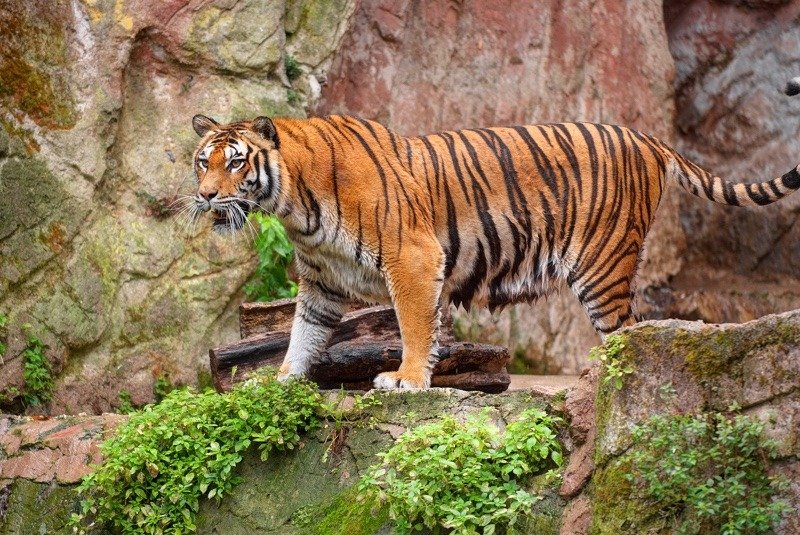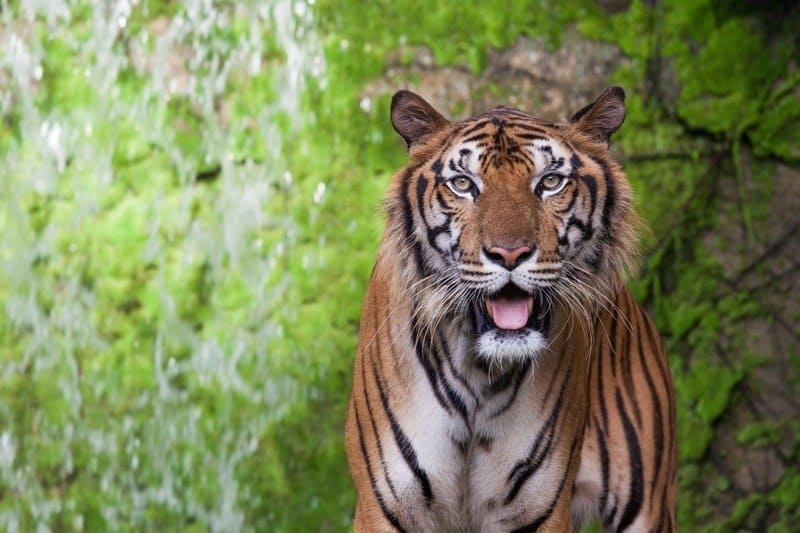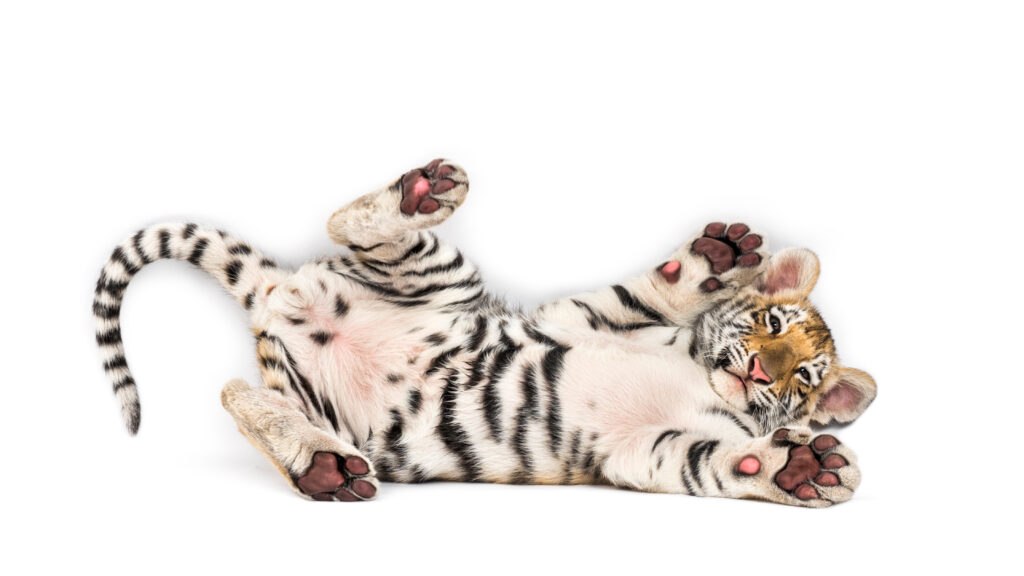South China Tiger
Panthera Tigris Amoyensis
There are less than 20 in the wild!
Advertisement
South China Tiger Scientific Classification
- Kingdom
- Animalia
- Phylum
- Chordata
- Class
- Mammalia
- Order
- Carnivora
- Family
- Felidae
- Genus
- Panthera
- Scientific Name
- Panthera Tigris Amoyensis
Read our Complete Guide to Classification of Animals.
South China Tiger Conservation Status
South China Tiger Facts
- Main Prey
- Deer, Cattle, Wild Boar
- Habitat
- Dense tropical forest
- Predators
- Human
- Diet
- Carnivore
- Average Litter Size
- 3
View all of the South China Tiger images!
“The South China tiger is a powerful predator, an expert hunter, and an old cultural symbol of regal strength.”
This subspecies is also perhaps the most imperiled tiger in the world. In precipitous decline since the 20th century, it is now confined to a very small range in China, and the only known live specimens reside in captivity. Conservationists are racing against the clock to save this animal from ultimate extinction.

4 Incredible South China Tiger Facts
- The South China tiger may have split off and evolved from an older lineage of tigers, which means it is more similar to the ancient tiger type rather than recent types. This is inferred from genetic analysis and observations of their physiology.
- The stripes on a tiger are somewhat comparable to a human fingerprint. Because of their unique nature (no two tigers have the exact same patterns), the stripes can be used to help identify individuals.
- Tigers have an enormously strong bite. They are able to crack open an animal’s skull with their jaw.
- The Guangdong Southern Tigers basketball team is named after this animal.
Scientific Name

The South China tiger is a subspecies of tiger and is closely related to the
snow leopard
.
©Mikhail Leonov/Shutterstock.com
The South China tiger is a subspecies of the common tiger. It goes by the scientific name of Panthera tigris amoyensis. This name is possibly derived from the local Amoy dialect, which is spoken in the southern city of Xiamen (historically known as Amoy) and its surrounding areas.
Despite being separated by geography, it is very closely related to the Bengal tiger, Siberian tiger, Malayan tiger, Caspian tiger, and Indochinese tiger. It is believed that all of these types are capable of reproducing viable offspring with each other since they are all part of the same species.
Somewhat more distantly, the South China tiger belongs to the same genus, Panthera, as leopards, lions, and jaguars. Although separated by millions of years of evolution, tigers have been known to produce hybrids with lions in captivity. The tiger’s family, Felidae, includes all known cats in the world.
Evolution

Fossil records show that tigers originated in China around two million years ago.
©iStock.com/it:Backiris
The earliest fossil record of a tiger was found in China and is believed to have lived two million years ago during the Pleistocene era. This evidence suggests that tigers originated in what is now China with Panthera zdanskyi, the Longdan tiger, being the most primitive tiger species. By the end of the Pleistocene, tigers had spread to the north of Asia, India, the bridge of Beringia, the island of Sakhalin and Japan.
The genus, Panthera, made up of tigers, lions, leopards and jaguars are all closely related to each other. In 2010, it was discovered that tigers are more closely related to the snow leopard – and that they diverged from the rest of the group 3.2 million years ago.
Appearance

No two tigers stripes are exactly alike.
©Deer worawut/Shutterstock.com
The tiger is the picture of power, thanks to its broad shoulders, large limbs, massive jaw and bite power, and sharp claws. It has the ability to drag away animal carcasses just as large, if not larger, than itself. Despite its enormous size, however, the South China tiger is possibly the smallest tiger subspecies in the world. Male tigers measure 6 to 6.5 feet long and weigh 330 pounds. Females are approximately 5 feet long and weigh 240 pounds. It is also possible to distinguish this subspecies from the slight difference in skull shape and teeth.
Stripes
The most striking aspects of the tiger are its sheer size and memorable coloration. This color is a mixture of reddish-orange, almost yellow, around most of the body (generally more vivid in color than other tiger subspecies) and white around the legs, chest, and parts of the face. The signature black stripes, which are long and narrow along the body, allow the tiger to maintain camouflage while moving in dense foliage. All of this is combined with yellow eyes and a pink snout.
Behavior

South China tigers are excellent swimmers that can chase prey for miles down rivers and lakes.
Preferring to avoid avid social gatherings, the tiger does almost everything on its own and only comes together for breeding and child-rearing. When it meets another tiger, it has a suite of vocalizations to signify its emotional state, including fear, anxiety, dominance, and submission. The tiger also leaves behind scent markings through its urine to find mates or mark territory. It will sometimes police the territory aggressively against outside intruders.
The tiger prefers to hunt almost exclusively from the ground, but it does have the remarkable ability to climb trees and swim across large bodies of water. This swimming ability is so prolific that it can chase prey for miles down rivers and lakes. It also bathes in water to keep cool from the hammering summer sun.
One of the more unusual characteristics of the tiger is the presence of false eyes on the back of its head. Their purpose is not entirely clear, but the false eyes may deter potential predators from behind or help cubs follow their mother.
Because of its rarity, almost everything we know about this South China tiger subspecies comes from studies and observations in captivity or documents from the past. Very few members of the subspecies have been cited in the wild since the 1960s and 1970s.
Habitat

South China tigers can adapt to many habitats but prefers forests and woodlands.
As recently as the 19th century, the South China tiger inhabited a huge range of territory throughout most of central China, including as far south as Hong Kong, but hunting and habitat loss have reduced it to a fraction of its former size. The last known group of tigers frequented a very narrow stretch of territory in south-central China. This distribution is highly isolated from other tiger subspecies, so there is no chance of them interbreeding.
The South China tiger can thrive in several different habitats, though it prefers forests and woodlands. A single individual can maintain multiple dens in caves, hollow trees, or dense vegetation but some tigers spend much of their lives in constant motion with no permanent home. The tiger’s territory, and the lengths to which it will travel to find food, largely depend on the number of prey in the area.
Population
According to the IUCN Red List, the South China tiger has been critically endangered since 1996. It is now possibly extinct in the wild since the last confirmed tiger sighting was in the 1990s. Some reports of wild tigers still existing are known to be fraudulent or unconfirmed. However, even if a few individuals exist in the wild, they are unlikely to stage a comeback on their own, as the numbers are too low.
This does not mean the subspecies are completely extinct. As of 2007, there were still approximately 70 individuals being kept captive in zoos or breeding bases, most of which reside in China. All of these specimens are descended from captive rather than wild-born populations. The South China tiger represents only a small fraction of the 3,500 or so tigers left in the world.
Diet

The preferred diet of the South China tiger consists of large hoofed animals, including antelope, deer, and wild boar. Only if larger prey is exhausted or difficult to find will the tiger begin to pursue smaller prey such as birds, fish, frogs, and rodents. Very rarely will a tiger hunt and kill humans, but once it has acquired a taste, it may continue to hunt people for the rest of its life. Humans may make a tempting meal for tigers too wounded or old to catch their normal prey.
While on the prowl, the tiger sneaks carefully through the foliage and strikes its prey with a single, swift motion, sinking its teeth and claws into the back of the neck or skull. If this is done effectively, then it will kill the animal almost instantly. The dead carcass is then dragged into cover and fed on over the course of several days. The tiger eats most of but not the entire carcass. It has huge projections on its tongue, which are known as papillae, to remove flesh from the bone.
Although it is incredibly big and powerful, the tiger also requires an equal amount of food and territory to sustain itself. A single tiger needs somewhere between 20 and 25 square miles of hunting territory, and altogether, it can eat up to 90 pounds of food in a single meal. The tiger feasts on as much food as it can, as it can go several days or weeks before finding its next meal.
Predators and Threats

Tigers are apex predators with humans being their main threat.
©SagarGosavi.Photography/Shutterstock.com
The South China tiger is an apex predator. It has no other natural predators in the wild, but there are nonetheless several threats to its survival. Tigers can be wounded and killed by larger prey, and adults are also known to sometimes kill young cubs. Due to negligent or even hostile actions by humans, the number of South China tigers dwindled dramatically over the course of the 20th century. Climate change could make it more difficult for numbers to improve in the future by altering their natural habitat.
Reproduction and Life Cycle

Tiger cubs stay with their mothers for 18 months or longer.
©Eric Isselee/Shutterstock.com
The South China tiger does not have a specific breeding season. This leaves it free to breed throughout the year, but it does tend to prefer the winter and spring months. The female will usually signal to the males via scent markings or vocalizations when she is in heat. This will sometimes induce males to compete with each other for access to reproductively available females.
After a pair mates, the male once again resumes its normal activity, while the female is left alone to carry the young for approximately 100 days before giving birth. A normal litter consists of one to four cubs at a time, only rarely more. The mother’s main duty is to protect the cubs, feed them, and teach them to hunt and survive until they are about 18 months old, after which they are free to roam off on their own and embark on a new independent life. Some cubs may stay with their mothers for longer.
It takes about three or four years for females to reach full sexual maturity; slightly longer for males. Because of these long maturation times, females only give birth every three to four years, which greatly slows population growth. The typical tiger lives approximately 10 years in the wild. However, some members of the species have been known to live more than 20 years, particularly in captivity.
View all 293 animals that start with SSouth China Tiger FAQs (Frequently Asked Questions)
What is being done to save the South China tiger?
Several local Chinese and international organizations, including Save China’s Tigers and World Wildlife Fund, are working to save the South China tiger from ultimate extinction. The most promising plan is to breed the tigers in captivity and release them into special tiger reserves throughout China. The return to the wild can be combined with better outreach to local communities and the protection of livestock from tiger attacks. However, due to the low population numbers, poor genetic variation, low birth rates, and high energy and territorial requirements, it is not guaranteed that the subspecies can recover fully. Even if a suitable habitat is found, the tiger will need ample amounts of prey animals to sustain adequate population numbers.
Why is the South China tiger endangered?
The South China tiger is endangered for several reasons. First, the population has been disrupted by habitat loss from logging and agriculture. Because of its enormous territorial range, the tiger is particularly sensitive to territorial fragmentation. Second, the decimation of its traditional food sources may have limited the number of tigers that can be sustained in the wild. A third major problem is deliberate hunting. Due to repeated attacks on livestock and people, the tiger was made a target of the government’s anti-pest campaign in the 1950s. Combined with illegal hunting and trading for tiger parts (including its fur), this campaign of indiscriminant extermination was so successful that numbers dwindled from 4,000 in the 1950s to a mere 30 by the latter part of the 20th century. The Chinese government eventually classified it as a protected species in the 1970s, but by then it was too little, too late to halt its inevitable decline.
How did the South China tiger evolve?
Genetic analysis reveals that the tiger as a species probably began evolving some 3.2 million years ago. Its closest living relative is the snow leopard, while the jaguar, lion, and leopard are more distantly related. The tiger probably radiated outward from somewhere in Central Asia. As mentioned previously, the South China tiger might be one of the earliest still living variations of the species.
Are South China Tigers herbivores, carnivores, or omnivores?
South China Tigers are Carnivores, meaning they eat other animals.
How fast is a South China Tiger?
A South China Tiger can travel at speeds of up to 60 miles per hour.
How to say South China Tiger in ...
Thank you for reading! Have some feedback for us? Contact the AZ Animals editorial team.
Sources
- Tigers-World, Available here: https://www.tigers-world.com/south-china-tiger/
- Animal Diversity Web, Available here: https://animaldiversity.org/accounts/Panthera_tigris/
- Zhihou Xia for Britannica, Available here: https://www.britannica.com/explore/savingearth/the-south-china-tiger-how-a-hoax-led-to-new-help-for-an-endangered-cat
- Matt Walker for BBC, Available here: http://news.bbc.co.uk/earth/hi/earth_news/newsid_8512000/8512455.stm
- World Wildlife Federation, Available here: https://www.worldwildlife.org/species/continental-tiger

















